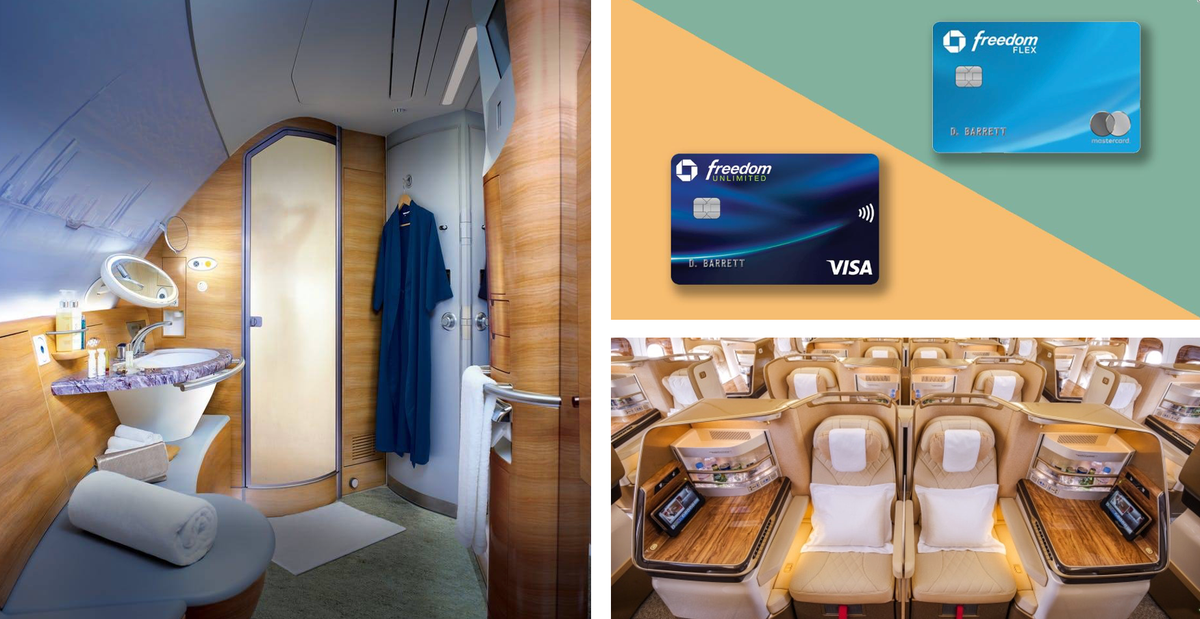250,000 Chase Ultimate Rewards Points: Ditch Basic Trips and Unlock Next-Level Travel Magic
250k UR points can fund a $10K+ luxury trip: think first class suites, overwater villas, or flying your whole family in business. Cover multiple 5-star hotel stays, plan a round-the-world itinerary, or enjoy a honeymoon-level escape—all on points. High-end travel, no cash.


If You Only Had 60 Seconds to Read This Article (Click Here)
With 250,000 Chase Ultimate Rewards (UR) points, you’re equipped to plan ultra-luxury travel worth $3,750 via the Chase portal (Sapphire Reserve at 1.5¢/pt), but you can unlock $7,500–$10,000+ in value through strategic transfers. Options include Singapore Suites (e.g., JFK–SIN ~264k RT), Emirates First via Skywards (136k one-way to Dubai) or via Aeroplan (100k one-way, no fuel surcharges), or two ANA First Class one-ways (~85k–90k each) via Virgin Atlantic for you and a companion. For practical use, 250k also easily covers two round-trip business class tickets to Europe(e.g., 60k x 4 segments with Aeroplan), or 5–6 round-trip economy tickets for families. Points also go far with Flying Blue Promo Rewards (business for ~45k OW) or Avios (e.g., Qatar Qsuites from 70k one-way).
On the hotel side, 250k UR transferred to World of Hyatt enables 3–4 nights at top-tier Category 7–8 properties (like Park Hyatt Maldives at 30k–35k/night), or 8–10 nights at mid-tier hotels (Category 4–5 at 15k–20k/night). This can fund multiple 5-night vacations or a luxury resort stay in an overwater villa. Alternatively, Marriott (if a 65% transfer bonus is available, turning 250k UR → 412k Bonvoy) could get 5 nights at a St. Regis or Ritz-Carlton (~80k/night with 5th night free). For the best point value, Hyatt still dominates (~2–4¢ per point vs. Marriott’s 0.7–1¢). A balanced redemption strategy might look like 150k UR to flights and 100k to Hyatt, creating a complete flight + hotel premium experience.
Examples of ultra-high value redemptions include: 240k UR → Virgin Atlantic = two ANA First Class one-ways(worth ~$20,000 retail), or 250k → Aeroplan + Avios to engineer a round-the-world trip in business class (e.g., U.S. → Europe (stop) → Asia → return via Middle East). You could also do an “ultimate honeymoon” with Qatar Qsuites to Maldives (~140k Avios for two) + 3 nights at Park Hyatt Maldives (105k UR). A business class Europe trip + luxury Paris hotel (e.g., 110k for flights + 150k Hyatt for 5 nights) is also viable. Even year-long travel becomes possible with ~10 nights at Cat 6 Hyatt hotels (25k/night = 250k total), spread across multiple destinations.
Execution strategy matters: always transfer UR only after confirming availability, and prioritize scarce flight segments first. Watch for transfer bonuses (e.g., 30% to Virgin or Avios) to stretch value. Avoid orphaning points across too many programs – focus redemptions for full experiences. Be aware of fees: e.g., Emirates Skywards First RT can include ~$1,000 in surcharges, which Aeroplan avoids. Leverage elite status (Hyatt Globalist, etc.), travel insurance via Sapphire Reserve, and perhaps even consider booking help for complex itineraries. 250k UR gives you massive leverage – whether you splurge once or spread out multiple high-end getaways, use them deliberately for transformative travel experiences.
Everything else you need to know is just below 👇🏻
Welcome to Ultra-Premium Travel Experiences
A quarter-million Chase Ultimate Rewards points – now we’re in truly rarefied air. 250,000 UR points can underwrite ultra-premium travel experiences that most people only dream of: think first class suites, multiple round-trip business class flights, or extended stays in extravagant hotels. At this level, you could essentially plan an entire luxury vacation (or several) with flights and hotels all covered by points. The opportunity (and challenge) here is deciding how to allocate such a windfall. Do you go all-in on one bucket list trip (like first class to Asia and a week at the Park Hyatt Tokyo and Maldives)? Or do you split it into a couple of high-end trips? The good news: there’s no wrong answer as long as you avoid poor-value uses. The tradeoffs are similar (cash vs. portal vs. transfer), but with 250k, transfers to maximize value become even more enticing – you’re in the range where you can simultaneously book multiple premium flights and hotels. Let’s explore how to wield 250k UR points for maximum travel ROI.
Transfer Partners Overview (250k Level)

With 250k at your command, you can mix and match multiple partners for one grand plan. You might use several transfer partners: e.g., 100k to an airline for flights, 150k to hotels, etc. Let’s highlight the major players:
- Singapore KrisFlyer (First Class Suites): At 250k, one partner that becomes very interesting is Singapore Airlines. Singapore often only releases premium cabin award space to their own KrisFlyer members. With 250k, you could book Singapore Airlines Suites (first class) round-trip on a route like New York (JFK) to Frankfurt to Singapore. For example, JFK-FRA-SIN in Suites might run ~SQ 132k miles one-way (as mentioned earlier). Round-trip that’s ~264k – slightly above 250k, but a transfer bonus from another program or a bit of extra UR could get you there. Even one-way in Suites for two people could be a play (e.g., ~240k for two one-ways JFK–FRA). Also, Singapore’s new A380 Suites from JFK to FRA to SIN is one of the most opulent experiences aloft – a true once-in-a-lifetime thing that 250k could secure one way for two, or round-trip for one. Alternatively, Singapore business class round-the-world: you could potentially do an open-jaw (fly into Europe, return from Asia via Singapore, etc.). KrisFlyer also offers the advantage of booking mixed cabin awards with stopovers if needed.
- Emirates Skywards (First Class extravagance): 250k UR puts Emirates first class within reach for a round-trip. For instance, New York to Dubai in Emirates First is 136k Skywards miles one-way (272k round-trip) plus substantial fees ($800+ round-trip). So 250k UR (maybe wait for a 15% transfer bonus that Emirates sometimes has) could yield 288k Skywards – enough for round-trip First Class to Dubai with some points to spare. Or consider New York to Milan on Emirates First, which is 85k one-way (170k round-trip); 250k covers that easily plus fees ($1,000 round-trip). You’d even have ~80k left, perhaps to position yourself or add on Dubai as a stop (Emirates allows a free stopover in Dubai on round-trip awards). Emirates First – shower spa, caviar, etc. – is a bucket list item for many, and 250k can realistically get two one-way tickets (so a couple can do it one-way together) or one person round-trip solo. However, consider using Aeroplan for Emirates: Aeroplan charges 100k one-way for Emirates First from US to Middle East (no fuel surcharges), so 200k for round-trip. That’s actually a better deal! 250k UR to Aeroplan could book one person round-trip Emirates First (200k) and you’d have 50k leftover – maybe to bring a companion one-way in business (because Emirates business via Aeroplan ~85k one-way). So weigh direct Skywards vs. Aeroplan’s chart.
- ANA via Virgin Atlantic (First Class for Two): Virgin Atlantic’s partnership with ANA remains one of the sweetest deals, even after devaluation, especially if you leverage a transfer bonus (which Virgin often gets from Amex, and occasionally from Chase). Round-trip ANA First from the US is ~165k Virgin points (from West Coast) up to 180k (East Coast). 250k UR transferred to Virgin (if a 30% bonus, 250k → 325k Virgin) could book two round-trip first class tickets on ANA (since ~180k each, 360k total, you’d be short ~35k but perhaps you have some Virgin already or could top up from another source). Without a bonus, 250k would get one person round-trip ANA First (180k) and one person round-trip ANA business (120k) – together 300k, a bit short. But you could do one-ways for two: e.g., both of you go to Japan in First (2 x 60k = 120k each way * 2 = 240k for two first class one-ways), then maybe come back in business or economy. That’s an incredible shared experience for a couple. Virgin/ANA is a prime example of stretching 250k into a “both of us fly first class” scenario.
- Multiple Business Class Seats (Family or Group Travel): 250k is plenty to get four round-trip business class tickets to Europe if you find saver space. Example: Air Canada Aeroplan charges ~60k each way to Europe in business on partners. Four round-trip = 480k, so 250k covers just over half – ok, maybe not four, but possibly twopeople in business to Europe and two in economy, mixing cabins for a family of four. Or using Flying Blue Promo awards at 45k one-way, you could get 4 one-ways in business and 4 one-ways in economy for 4 people round-trip. Alternatively, five or six round-trip economy tickets to Europe or Asia for a large family – 250k can do that easily (e.g., 6 x 40k round-trip to Europe = 240k). The partner programs to use might be United or Aeroplan (since they allow booking Star Alliance for multiple people if space exists). This level of points enables whole-family premium travel, which is a different but equally valuable kind of luxury – turning left on the plane with your spouse or kids, rather than just solo. If, for instance, you wanted to take your parents and spouse on a special trip, 250k could cover 3 business class tickets one-way and economy back, etc.
- World of Hyatt (Multiple Stays or Villas): With 250k Hyatt points, you could do something like: 5 nights in an overwater villa in Maldives (Category 7 or 8) for ~200k, and still have 50k for a weekend at a Park Hyatt elsewhere. Example: Park Hyatt Maldives is Cat 7 (30k/night standard, often 35k peak). Five nights at 30k = 150k. Many do 5 nights because that’s typically a nice length; no free night but that’s okay. That leaves 100k. Then maybe 3 nights at Alila Napa Valley (Cat 7, 90k) – you’ve just done two luxury trips on points. Or blow it all in one go: 6 nights at a Category 8 hotel off-peak (35k/night) = 210k, e.g., 6 nights at Ventana Big Sur (all-inclusive for adults) using points – that could be $1,500 a night cash, so $9,000 value for 210k points, plus you still have 40k left. At 250k, Hyatt’s relatively limited footprint might mean you consider splurging on suites via points. Hyatt lets you redeem more points for premium suites if available. For example, a standard room at a Category 6 is 25k, but a premium suite might be 40k. 250k could get you a week in a suite at a top hotel. Or use Hyatt points for multiple trips: it’s enough for perhaps three separate 5-night stays in mid-tier properties (like three different cities, Cat 4 hotels at 15k/night, 5 nights each = 75k each, total 225k). That could support a round-the-world tour lodging. Marriott with 250k (especially if you caught a 65% bonus making it ~412k Bonvoy) could also be useful – e.g. 5 nights at a St. Regis or Ritz that’s ~80k/night (with 5th free, 320k cost). You’d have enough Marriott to do that if a bonus was used. But Hyatt’s value is likely higher per point.
- Combination: Ultra-Luxury Itinerary: The 500k section will delve into yearlong premium travel, but even at 250k you can craft an ultra-luxury itinerary covering flights and hotels for one major trip. For instance: Fly two people round-trip to Europe in business (say 2 x 120k = 240k United miles, which you can get by transferring UR + maybe some from your partner). That uses most points. But what if instead: use 150k for flights and 100k for hotels. Example Trip: Two people to Paris in business (say 55k each one-way via Flying Blue = 110k, and maybe economy back or use cash sales coming back), and 5 nights at the Park Hyatt Paris (30k/night = 150k). That’s ~260k total; you might tweak one segment to economy or top up slightly. The value of that trip could be tremendous (biz class flights ~$4k each, hotel $1k/night). With 250k, these kind of aspirational combos are very doable, especially if you don’t insist everything is points (maybe pay cash for cheaper return flight to save points, etc.). Another concept: Two separate business class trips – one to Europe, one to Hawaii for example. 250k could fly two people business to Europe (120k each RT ~ 240k) and economy to Hawaii (or use remaining 10k plus a bit more for that). Or business to Asia for two (~150k each RT, needing 300k, so not quite, but maybe one way each in first etc.). You have to prioritize, but you have huge flexibility.
- Programs to Leverage for 250k: We’ve mentioned many: Aeroplan stands out (wide partnerships, stopovers, can book multiple complex tickets), Virgin Atlantic (for ANA, etc.), Avios (for multiple flights in maybe business class on Qatar or multi-region trips), Hyatt (for luxury stays), and United. Also, consider All Nippon Airways (ANA) Mileage Club – not a direct UR partner, but if you had Bilt or Marriott you could top-up. They have a RTW ticket for 220k miles in business class that covers up to 8 stopovers, but UR doesn’t transfer to ANA. Still, Aeroplan’s multi-stop might replicate that. Another angle: Chase’s Pay Yourself Back for Business Class deals – a new concept: with Sapphire Reserve’s refreshed perks, they have “Points Boost” where premium cabin flights can be redeemed at 1.5x or even 1.75x. If you find a relatively inexpensive cash business fare, using the portal might yield ~2¢ per point value now. E.g., a $2,000 business class fare to Europe could be booked for ~115k points via the portal (since 2cpp with Points Boost possible), arguably as good as transferring without hassle, and you’d earn miles for flying it. That’s something to consider for a portion of your 250k: maybe you use 115k for one fare via portal (with Points Boost doubling value) and transfer the rest elsewhere. At 250k, you have room to try different redemption strategies side-by-side.
High-Leverage Redemptions (250k Examples)
Let’s illustrate some ultra-high-value uses of 250k UR points:
- Two First Class Suites to Asia (One-Way): Use ~240k UR -> Virgin Atlantic Flying Club to book two ANA first class seats from the US to Japan (currently ~90k each one-way from East Coast, 85k from West Coast, so 180k total West or 180k- for East with devaluation – you’d have enough). That leaves some points for positioning flights or a hotel night. This one-way journey (maybe LAX to Tokyo for 2 people in “The Suite” first class) would retail for easily $20,000 total. You’d be getting ~8-10¢ per point value – phenomenal. You then could return in business class on points or catch a paid fare sale home. But that outbound will be a lifetime memory.
- Around-the-World in Business Class: 250k, when used on Aeroplan or a combination of programs, can create a near-RTW. For example: Book a One-way Aeroplan multi-stop: USA -> Europe (stopover) -> Asia (destination) for ~87.5k +5k = 92.5k in business, and then return Asia -> USA via Middle East on another award (perhaps Asia to Doha to USA using Avios on Qatar, which could be, say, 75k + 85k =160k Avios for two business class legs, you’d need to transfer maybe 160k UR to BA for that). So total ~252.5k UR (92.5k Aeroplan + 160k Avios) yields US->Europe->Asia (with a stop in Europe) and Asia->US via the Middle East. That’s effectively a round-the-world (US->Europe->Asia->US), in business class the whole way.
- First Class + Business Class Dual Trip: 250k could be split into two big trips: Trip 1: Solo first class somewhere. Trip 2: Couple in business somewhere. For instance, spend ~120k on a one-way in Emirates First and a five-star hotel night in Dubai for yourself, and the remaining 130k to fly you and your partner round-trip to Hawaii in first class (which might be via British Airways Avios on American for 80k each RT first class from West Coast, total ~160k for two, or use 130k to offset with some cash). Or more practically, Trip 1: You and your partner to Europe in business (2 x ~120k = 240k), Trip 2: You alone go to a conference or bucket list location in business (say 110k for a RT to Asia). Oops, that’s more. Actually 250k might be more elegantly split as ~125k per trip. For 125k, a couple can do a nice one-way in business to somewhere not too far or economy round-trip etc. Lots of combos.
- Year of Luxury Hotels: If you’re more hotel-focused, 250k UR to Hyatt could let you bounce around some of the best properties over a year. E.g., 3 nights at Park Hyatt New York (40k/night = 120k), 3 nights at Alila Ventana Big Sur (45k/night, but all-inclusive, need 135k for 3 nights peak, a bit short but do 2 nights = 90k), and 5 nights at Miraval Resort (which is all-inclusive wellness, 65k/night for two with points, 4th night free for cardholders; say 4 nights = ~195k, not enough in isolation but you see the idea). Perhaps instead, 250k can do 10 nights in Category 6 hotels (25k each = 250k) – maybe five 2-night weekend getaways at various Andaz/Grand Hyatts around the world. Or cover all your hotel needs for several vacations: 5 nights Paris (150k Cat7), 5 nights Bali (75k Cat4), etc.
- Mixed Redemption “Ultimate Honeymoon”: Picture this: Fly Qatar Qsuite business class to the Maldives for two (Qatar via Avios: e.g., New York to Male is ~70k Avios per person one-way in business via Doha, 140k for both; return maybe 75k each = another 150k, total 290k needed round-trip for two; so maybe one way on points, one way find alternative). But let’s say one-way on points: 140k gets you there in Qsuites, then use 110k UR -> Hyatt for 3 nights in an overwater villa at Park Hyatt Maldives (35k/night *3 = 105k). That’s ~245k UR spent for a half-week ultra-luxury honeymoon (flights there in one of best business classes, a few nights in an overwater villa). You might pay cash or use card free night certs to extend further, but the anchor experiences are points-paid. The value is huge (business flights worth ~$5k each, hotel $1k/night).
In all these, 250k is enabling either super expensive flights for two or combining flight + hotel of a high caliber.
Booking & Execution Strategy
Managing 250k points requires an almost project-management approach, especially if you’re dividing them among multiple redemptions:
- Create a Master Plan: List out the components you want – e.g., First Class flight A -> B, business B -> C, hotels in city B and C, etc. Then assign which points or partner will fund each. Because you can do so much, it’s easy to get scattered. Having a clear plan (maybe even a spreadsheet of segments, ideal programs, and points needed) will help. This also ensures you allocate points optimally – for instance, you wouldn’t want to use all 250k on flights and have none for hotels if hotels are super pricey at your destination. Balance as needed.
- Stagger Your Bookings: If you’re planning an ultra-luxury trip that’s say 9-12 months out, book in phases. For instance, book flights as soon as the schedule opens (with relevant points). Hyatt hotels you can book 13 months out; do that early if it’s peak season at a popular resort. If transferring to multiple partners, maybe lock in the hardest-to-get item first (often the award flight in first/business, since those can be few seats). Hotels typically have more availability, especially Hyatt which doesn’t cap capacity beyond standard rooms. So prioritize scarce items. If doing a multi-stop award, ensure you have all points in the account before calling (e.g., transferring to Aeroplan ahead of time if you plan a complex itinerary by phone).
- Mind the Validity of Points & Tickets: With large balances across programs, keep track of expiration. Some might require activity (Avios expire after 36 months no activity – easy to reset by earning or spending some; Singapore miles 3-year hard expiry). If you transfer 250k into one place like Singapore, be absolutely sure of usage because the clock ticks. Maybe only transfer as needed for each booking rather than all at once. On tickets: if you book a bunch of separate awards for one trip, note all reference numbers. If one flight changes, it could affect a downline segment on separate award. At this luxury level, consider travel insurance or booking with a card that has strong protections (trip delay, etc.). If one segment is Emirates and another separate on Cathay, etc., they won’t protect missed connections, so plan buffers or stick to one alliance if possible for easier protection.
- Phone a Friend (Agent): Some of the best redemptions at this level may require calling. E.g., booking stopovers with Aeroplan can be done online mostly, but multi-city can bug out – agents can manually build. Complex routing like around-the-world might be easier via phone. Prepare ahead: feed the agent the flights you want segment by segment. Often they won’t be as imaginative, so you do the research (using tools like Aeroplan’s multi-city search or ExpertFlyer to find flights) and then call to feed it to them.
- Fee Management: At 250k usage, you might face some sizable fees (fuel surcharges on first class, etc.). Budget for them. For example, if you plan BA First or Emirates via Skywards, know you might spend $1,000+ in surcharges. If that’s unpalatable, adjust to use programs that minimize fees (Virgin on ANA, Aeroplan on Emirates, etc.). Also, some countries have high departure taxes in premium cabins (UK APD is hefty for biz/first). Maybe avoid starting in London – instead, fly out of Paris or Amsterdam to cut costs. For instance, with Avios, you could start your BA first class in EU instead of London, saving a lot of APD.
- Elite Status Consideration: If you are going big on hotels, having elite status (Hyatt Globalist, Marriott Platinum, etc.) can really enhance the experience (free breakfasts, suite upgrades). With 250k and presumably significant spend pattern, you might have some statuses or can pursue them. Timing a trip after achieving status can increase enjoyment (e.g., do your big Hyatt stay after you hit Globalist via 60 nights or a milestone event). For flights, you’ll likely earn a ton of miles if you pay cash, but on awards you don’t get status miles. So no direct effect except enjoying lounge access that comes with premium cabin anyway.
- Combining with Cash for Upgrades: Another tactic at 250k – you could also consider booking a cash ticket and using points to upgrade. For instance, United allows upgrades with miles (plus co-pay) from economy to biz or biz to first on some routes. Not always the best value, but if you find a good fare, an upgrade might cost fewer points than an outright award. British Airways Avios can upgrade paid premium economy to business on BA flights at reasonable Avios rates. If you have 250k, you might allocate some to upgrading a trip where you found a deal in premium economy. However, for simplicity, straightforward award bookings are often better.
- Plan for Devaluation Safeguards: If your travel is far out (late 2025 or 2026), beware that programs can devalue. Spread risk: maybe don’t transfer all points to one airline far in advance; maybe book one trip for 2024 and another for 2025 rather than saving all for one 2026 blowout. That way if one program devalues, you still have some other points in Chase that you can redirect.
Pitfalls & Red-Flag Redemptions
Even with a mountain of points, you must avoid pitfalls that can lead to suboptimal outcomes:
- “Jack of All Trades, Master of None”: With 250k you might be tempted to dip small chunks into many different programs (“maybe 20k here, 30k there, just to see”). This can lead to fragmentation and orphaned points. It’s often better to make a bold, concentrated redemption than several half-measures that don’t fully deliver the experience or value. For instance, spending 250k to put everyone in economy when you could have put half the group in business and really enjoyed it might feel like a miss in hindsight (depending on your group’s preference). Don’t dilute the value; focus on what will mean the most.
- Letting the Tail Wag the Dog (i.e., points dictating plans): It’s great to maximize value, but don’t force a redemption just because it’s “max value” if it’s not something you actually want. Example: Redeeming 250k for four first class tickets to somewhere you aren’t excited about, just because first class is expensive, is backwards. Better to use maybe 200k for two first class tickets to a place you do want to go, and 50k wasted or not, at least the trip is meaningful. At this level, focus on the experience gained, not just the numeric value. Use points to fulfill travel dreams, not just to play a numbers game.
- Ignoring Taxes/Surcharges Multi-fold: We mentioned fees at 100k, but at 250k you might do multiple high-fee awards. If you redeem Emirates, BA, and Lufthansa first in one year, you could owe a few thousand in fees total. Ensure that’s factored in your budget. Don’t blow points and then be unable to enjoy the trip fully due to out-of-pocket costs. It could be better to take slightly lower “cent per point” value via a program that has no surcharges (Aeroplan, United) than to be cash-strapped paying fees for maximum point value. It’s about total trip cost, not just points efficiency.
- Burnout and Overbooking: A funny pitfall – with so many points, you might over-schedule travel because it feels “free.” But remember your own time off work, personal energy, etc., are limited. Some people new to luxury travel may try to do too many stops (like 5 cities in 2 weeks because all flights were free). That can lead to fatigue and diminished enjoyment. Yes, you have points to fly anywhere, but pace yourself so that each redemption is savored, not rushed. Points enable, but don’t feel obligated to use them all at once or to travel in a way that doesn’t align with your style.
- Holding Too Many Points for Too Long: We covered not hoarding at 100k, and at 250k this applies even more. This is potentially years of credit card spend/bonuses. If you keep stockpiling beyond 250k without an outlet, you risk devaluations or even losing points (account closures or such, rare but possible if bank issues, etc.). Make a plan to use the bulk of them within, say, 2 years. If you’re saving for a specific goal (e.g., a 2026 massive trip), fine – but then don’t concurrently accumulate another 250k that sits until 2030. As points stacks grow, the incentive for programs to devalue grows too (lots of liabilities on their books). So use them to avoid disappointment.
- Not Considering Selling/Shopping Portals (Temptation): 250k UR theoretically equates to a lot of merchandise via the Apple or Amazon redemption options (~$2,000 at 0.8¢ on Amazon, ~$2,500 at 1¢ on Apple). Resist the temptation to blow a portion on gadgets or gift cards because “I have so many points.” Those are poor value redemptions. If you really want a MacBook, it’s better to pay cash (or use a lesser points rebate like a credit card’s cash back) and save UR for travel. The experiential value of travel usually outweighs that of consumer goods – at least that’s the premise you had in earning these points.
- Losing Focus of Earning Side: One subtle pitfall – being so rich in points that you become less disciplined in earning behavior. For example, you might stop using the right cards for bonus categories or miss out on new sign-ups because you think “I already have plenty.” But points have no yield sitting around, and your needs may increase (maybe you’ll want first class all the time now!). Keep up good habits – continue maximizing category spend (like using Freedom 5x or Ink for businesses) and grabbing lucrative bonuses. 250k can go faster than you think if you start traveling lavishly. So, don’t let the big balance make you complacent; keep feeding the machine so you never run out when needed.
Summary & Strategic Advice
Quarter of a million Ultimate Rewards points puts you in elite company in the points world – and opens travel possibilities that are virtually limitless. It’s the equivalent of tens of thousands of dollars in travel when used wisely. At 250k, you should be thinking in terms of travel portfolios: you can allocate points to multiple goals – say, one aspirational first-class flight, one luxury hotel stay, and one additional trip in business class – rather than having to choose one over the other.
Who benefits most from 250k?
The ultra-frequent traveler or luxury enthusiast who wants top-notch experiences without paying top-dollar. It’s ideal for someone planning a big honeymoon or anniversary trip with all the bells and whistles – first class flights, private transfers, overwater villas, etc. It’s also fantastic for a family who wants to elevate their travel comfort (maybe flying the family business class on vacation, or staying in multi-bedroom suites via points). At this tier, even business travelers who have accumulated points might use 250k to upgrade work trips or extend into leisure trips (bleisure) at high end hotels. Essentially, anyone who values premium travel and has the flexibility to plan can derive enormous value.
When to burn vs. hold
If you’ve reached 250k, strongly consider using a significant portion in the near to mid term. Airlines devalue incrementally; hotels too. You’ll rarely regret using points for an amazing trip, but you might regret saving them too long and finding your dream redemption now costs 350k. That said, if you’re targeting something specific like a 2026 around-the-world cruise (just example), by all means hold for that, but perhaps hedge by using some points for enjoyment in the meantime. With 250k, you could easily do a major trip now and still have points for another later.
Broader Chase strategy
250k doesn’t happen without strategic earning – likely you’ve maximized category bonuses (5x on office supplies, etc.), sign-up bonuses, and maybe business cards (Ink Business Preferred’s 100k bonus, etc.). Keep that momentum. Also consider pairing UR with other ecosystems: maybe transfer some UR to United and some Amex MR to ANA to coordinate flights. Or use UR for Hyatt hotels, and use Marriott points from a Marriott card for other nights. At this stage, you likely have a diversified points portfolio; use each currency to its strength (UR for Hyatt/United, MR for ANA/Marriott if needed, etc.). Also, make sure to utilize Chase’s travel protections by booking any cash portions on your Sapphire Reserve (trip delay insurance, etc.), since you’re venturing far and wide on expensive trips – those perks are a safety net.
250k in a broader Chase strategy
This might also mean looking ahead: do you push toward 500k for an even grander objective, or start using them now? There’s no wrong answer, but remember that incremental value of points may diminish – the jump from 0 to 100k is life-changing in travel; from 250k to 500k is more luxury but perhaps not doublethe experience, depending on usage. So don’t feel you must hit 500k before spending; 250k is plenty to make magic happen now.
One strategic tip: if you have multiple UR-earning cards, combine points to your Sapphire Reserve before redeeming for travel portal or Pay Yourself Back to leverage the 1.5x or Points Boost. And if you have family members, you can transfer UR to one another’s accounts or directly to their loyalty accounts (with permissions) if, say, you want to gift them travel – very useful.
In conclusion, 250,000 UR points is a travel game-changer. It grants you the freedom to travel in first class cabins, stay in suites, and craft complex itineraries that touch multiple continents – largely on points. The key is to plan deliberately, execute carefully (mindful of program rules and fees), and then let yourself enjoy the fruits of your points. At this level, the focus shifts from just “free travel” to “exceptional travel experiences”. You have the means to fly in the pointy end of the plane, to sleep in beds above the clouds, to dine at high-end hotel restaurants – in short, to travel not just for free, but in style. Use that power wisely and it will reward you with memories that far outlast the points themselves. Safe travels and happy upgrading!




